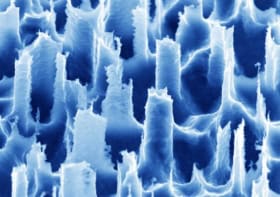
A study on photoplethysmography (PPG) algorithms has won its authors the Martin Black prize, awarded to the best paper published in Physiological Measurement during the previous year.
PPG is an optical technique commonly employed in smartwatches, fitness trackers and pulse oximeters to monitor physiological parameters. A key step in analysing the PPG signal, a measure of the pulse, is detection of individual heartbeats in the signal. In their award-winning investigation, Peter Charlton from the University of Cambridge and collaborators evaluated the performance of the different algorithms used to detect heartbeats in PPG signals.
The paper, Detecting beats in the photoplethysmogram: benchmarking open-source algorithms, describes a framework for testing PPG beat detection algorithms. The researchers used this approach to assess 15 open-source algorithms against reference beats from electrocardiogram signals in eight freely available datasets. They also investigated how algorithm performance is affected by patient demographics and during arrhythmias (abnormal heart rhythms such as atrial fibrillation).
“I was keen to understand how best to detect heartbeats in the PPG and to understand how well they could be detected in different settings, such as during exercise and in babies,” says Charlton.
The team found that most beat detectors performed well in the absence of movement, though their performance was poorer during exercise, in neonates (who have higher heart rates than adults) and during atrial fibrillation. In particular, the results identified two open-source algorithms that performed best across a range of use cases. Charlton suggests that the team’s use of open-source algorithms may be key to the study’s success, as people can easily employ the recommended beat detection algorithms by simply downloading them and viewing the source code.
The study should prove valuable for academic researchers who need to ensure that their PPG signal analyses are accurate, as well as enabling device designers to select the most appropriate algorithm for use in a device. Charlton says that the findings will also be helpful for clinicians. “Hopefully, the use of the best-performing algorithms will result in more accurate analyses – such as assessing heart rhythm and detecting arrhythmias from the PPG,” he explains. “Ultimately, it will be helpful to patients, as the measurements taken from them will be more accurate, leading to better-informed clinical decision making.”
Charlton and colleagues are currently conducting the SAFER Wearables Study to investigate the performance and acceptability of wearable devices for detecting atrial fibrillation, the most common arrhythmia. Atrial fibrillation increases the risk of stroke and is often not recognised because it can occur without symptoms. Once diagnosed, however, well-established interventions exist to reduce the risk of stroke.
“Detection of atrial fibrillation is one of the most promising applications of PPG-based devices,” says Charlton. “In this study we are assessing whether PPG-based devices perform well enough to be used to screen for atrial fibrillation in the general population. If so, this could help improve the detection of atrial fibrillation, and ultimately contribute to preventing strokes.”

The science and scientists of Don’t Look Up, low-cost optical technique is improving healthcare
Charlton tells Physics World that he was pleased to receive the Martin Black prize as it hopefully indicates that the team’s research is helpful. He points out that beat detection has received less attention than other algorithms, such as those used to estimate blood pressure from the PPG. “I think the community probably particularly valued an assessment of this type of algorithm, as comparatively less was known about their performance than other types of algorithms.”
“I am grateful for the input of team members, and those who originally developed the algorithms, without which this work would not be possible,” he adds. “I’m interested in exploring why we were awarded this prize, because understanding this might help us understand the most valuable areas we could work on in the future.”



